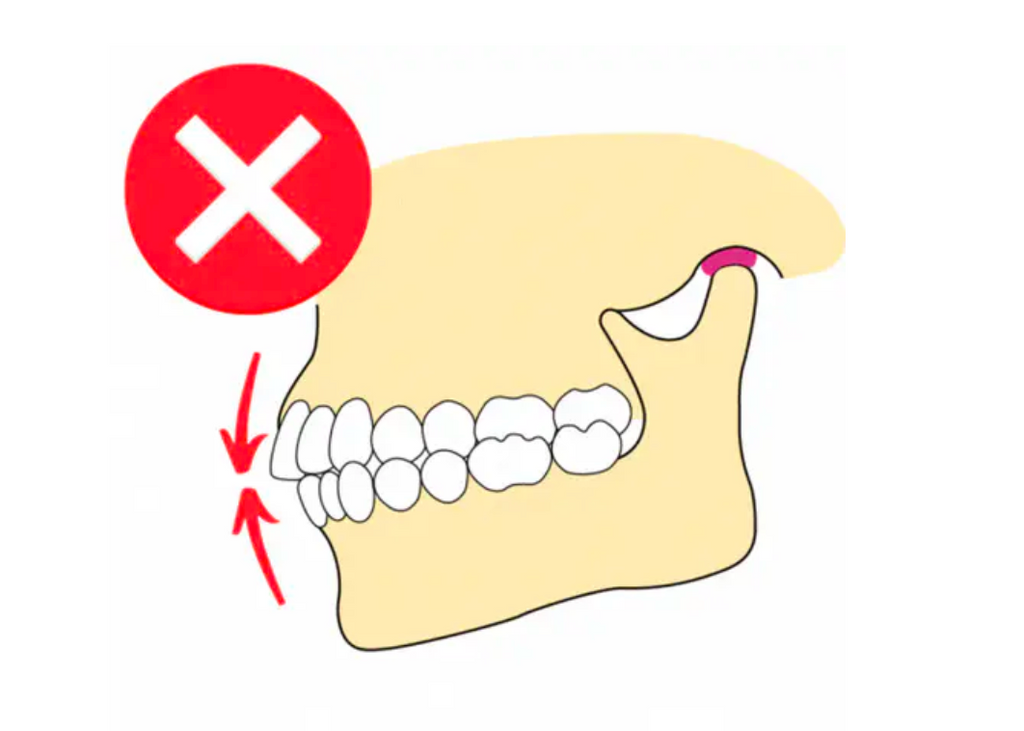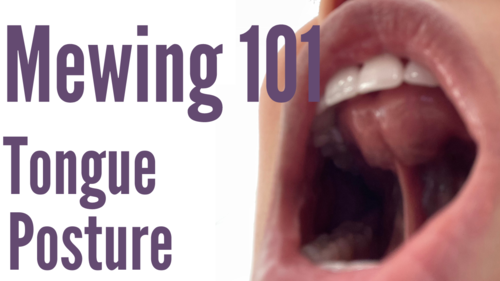
Which position is your tongue in right now?
The correct tongue position whenever your face is resting is A, often called “Mewing.”
So what is "Mewing"? I often talk about Mewing, and it is NOT about a cat, but correct Tongue Posture®! Why is the correct tongue position called “Mewing?” It is because it is nicknamed after Dr. Mike Mew, a British dentist who started educating about it on YouTube and “Open Wide”, a Netflix show.
In a world where the quest for aesthetic perfection seems never-ending, mewing promises a revolution without needing a scalpel or surgery. At the heart of this phenomenon is the premise that something as mundane as the position of one's tongue could be the key to unlocking a more defined jawline, improved breathing, and an overall enhanced facial structure.
But how does one navigate the intricacies of how to do mewing properly? The journey is fraught with misinformation and myths, making a clear, concise, and accurate mewing tutorial more pressing than ever.
What is Mewing, And What Does It Do?
Mewing is proper Tongue Posture® that involves placing the tongue on the roof of the mouth, specifically the palate, rather than the bottom of the mouth or between the teeth. This is because when the tongue fully touches the palate, it helps lift the maxilla bone, resulting in a lifted face with numerous benefits.
Meanwhile, if the tongue is placed on the bottom of the mouth, the weight of the muscles pulls the face downward, leading to a sagging appearance. This is crucial, particularly for younger people, to master the correct Tongue Posture®.
Mewing is a practice rooted in the belief that tongue posture can influence facial aesthetics and health. This technique promotes proper nasal breathing, and overtime of practice leads to structural changes or aesthetic improvements.
Five Tips on How to MEW by Koko
Now, you might be wondering how to do that. Then let’s move on to the five tips to help you easily achieve proper Tongue Posture® aka Mewing.
-
Clicking
To perform the suction technique for proper Tongue Posture®, slowly press your tongue onto the palate before clicking it into place. This light suction or touching flat should be maintained for around 23 hours per day, including during sleep, to make it a habit and ensure constant correct Tongue Posture®, even unconsciously.
One Warning: Although I say “suction,” you should NOT be hard sucking. It should be lightly touched when your face is resting. “Suction” is only for this tip so that you can understand what mewing is like.
-
N Exercise
If the “Clicking” technique above does not work for you, try saying "N, N, N, N, N" while expanding your tongue slightly to the sides and fully touching the palate.
-
Swallow saliva only
Accumulate saliva in your mouth and then swallow while expanding your tongue slightly to the sides and fully touching the palate.
-
Drink water
This is similar to accumulating saliva, but this time, try the same swallowing with a slightly more liquid than saliva to work with. Slowly drink water, and expand your tongue slightly to the sides rather than the front when you swallow. This technique may be easier to feel and perform correctly and is a great example of how to drink more mindfully and effectively.
-
Slide, by feeling the speed bumps
It involves feeling the two-speed bumps on the palate. Begin by placing your tongue close to the throat and slowly sliding it along the palate while maintaining contact. You should feel a soft speed bump near the throat and a hard speed bump behind the upper teeth. Keep the same contact and pass both speed bumps to achieve full light suction on the palate.
A Step-by-Step Guide on How to Mew Properly

Step 1: Understand the Mewing Position
Place your entire tongue flat against the roof of your mouth, ensuring it's not just the tip but the entire surface making contact. This should support your facial structure effectively.
Step 2: Align Your Jaw
Proper jaw alignment is crucial for effective mewing. Your teeth should be close together, almost touching, yet avoid clenching. This is key for applying the appropriate pressure to reap the benefits.
Step 3: Engage the Entire Tongue
Although challenging, the full engagement of your tongue is critical for effective mewing, ensuring that you're engaging your muscles in a manner that promotes visible improvements.
Step 4: Practice Consistent Breathing
Maintaining your tongue's proper position while breathing through your nose. This upholds the desired posture and improves your breathing quality.
Step 5: Patience and Consistency
Aim to keep this posture as consistently as possible throughout your day. The more habitual the mewing position becomes, the more natural it will feel, leading to better results.
Step 6: Check and Adjust
Regularly check your tongue placement to ensure it maintains the correct posture. Adjustments are a normal part of the learning process, so be patient and flexible as you refine your technique.
Common Mewing Mistakes
Once you start practicing mewing exercises, some pitfalls are almost impossible not to fall into. Recognizing and avoiding common mistakes is crucial for those wondering how to mew correctly.
- Incorrect Tongue Position: One of the major mistakes people generally make while considering mewing effectively is a failure to engage the whole tongue, especially its back portion. This is a mistake that often leads to little to no improvements at all. Therefore, understanding the correct tongue posture is crucial.
- Failing to be Consistent: Much effort brings many results. Consistency is the key to mewing; thus, maintaining the proper position throughout the day is paramount. The journey requires patience and persistence, with the understanding that changes are gradual and cumulative.
Signs To Know If You Are Mewing Correctly
- Improved Nasal Breathing: One of the main ways to check if you’re doing correct mewing is enhanced breathing patterns through the nose. This improvement signals proper airway alignment and opening.
- Jaw Pressure or Tension: Initially, you may feel mild pressure or tension in your jaw and palate. This sensation indicates that the muscles are being appropriately engaged.
- Changes in Facial Structure: With time, you may notice slight alterations in facial structure or a tightening of facial muscles, pointing to the effectiveness of mewing.
Troubleshooting Common Issues
- Jaw Pain or Discomfort: Just like with any other exercise, pain will call you to take a pause and check. If you experience pain while mewing, it might be due to excessive force or incorrect tongue positioning. Lightening the pressure and aiming for an even distribution across the palate can ease the pain.
- Nasal Breathing Difficulties: Trouble breathing through the nose while mewing may mean your tongue obstructs the airway. Slight adjustments in tongue posture should enable proper mewing and comfortable nasal breathing.
Answering Some FAQs on Mewing
From the practicalities of technique to the expectations of outcomes, pursuing knowledge about mewing never ends. Below, we highlight the three most pressing questions that demand clarity and answers.
What are the important steps that should be taken to attain proper tongue posture while mewing?
There are critical steps in establishing proper tongue posture while mewing. First, ensure the whole tongue (not just the tip) makes good contact with the roof of the mouth; that's basic tongue posture in mewing. Secondly, the mouth should be generally closed, and the teeth should be in contact but not clenched. Finally, ensure this posture is maintained for a longer time for the best results.
How do you ensure that the back third of your tongue is involved every time you are mewing?
One of the effective ways for the back of the tongue to stay firm against the palate is to say the sound of "ng" like in "singing.” Doing this exercise helps you find the proper back half of your tongue's position for mewing. This is crucial as the improper mewing position wastes much time and effort. Those interested in mewing should aim to learn how to mew properly until it becomes second nature.
What are the mistakes that should be avoided to keep away from the danger due to wrong mewing practice?
Knowing the common pitfalls will enable mewing enthusiasts to avoid accidents, pain, and disappointments. Make sure you give less force with the tip of your tongue; how to mew your jaw is a gentle balance that won't tense up your muscles. Two, avoid a mewing tongue posture that obstructs breathing. Proper mewing should allow comfortable nasal breathing. Lastly, consistency without overexertion is critical; how does mewing properly involve a gentle, sustained effort rather than sporadic, forceful attempts? Avoiding these mistakes is essential for those committed to learning how to mew correctly and seeking the benefits of mewing how to improve facial structure and health.
A Future Full of Possibilities
For many, mewing represents a frontier of personal experimentation for improved health and aesthetics. Engaging with the practice offers an opportunity to explore the potential impacts of Tongue Posture® on one's well-being, guided by the principles of mindfulness and self-awareness.
The growing interest in mewing underscores the need for more scientific research to explore its efficacy and mechanisms. As the practice gains traction, it opens the door for deeper study by researchers and face yoga experts keen on unraveling more truths behind the claims and developing more plans to increase its effectiveness.

